Bistek Tagalog was our family's ultimate comfort food that turned ordinary weekday dinners into something special. I always love the way the tender beef soaks up the perfect balance of toyo and calamansi, while the caramelized onions add that subtle sweetness that makes you want to drench your rice with all that sabaw.
I've spent years perfecting this family bistek recipe. And honestly, that moment when everyone fights over who gets the last piece of beef and who gets to pour the remaining sauce over their rice, that's when you know you've nailed it.
This classic Filipino beef steak might look simple, but don't let that fool you: it's packed with those nostalgic flavors that remind you of beloved family gatherings and the warmth of home cooking that we Pinoys hold dear.
Jump to:
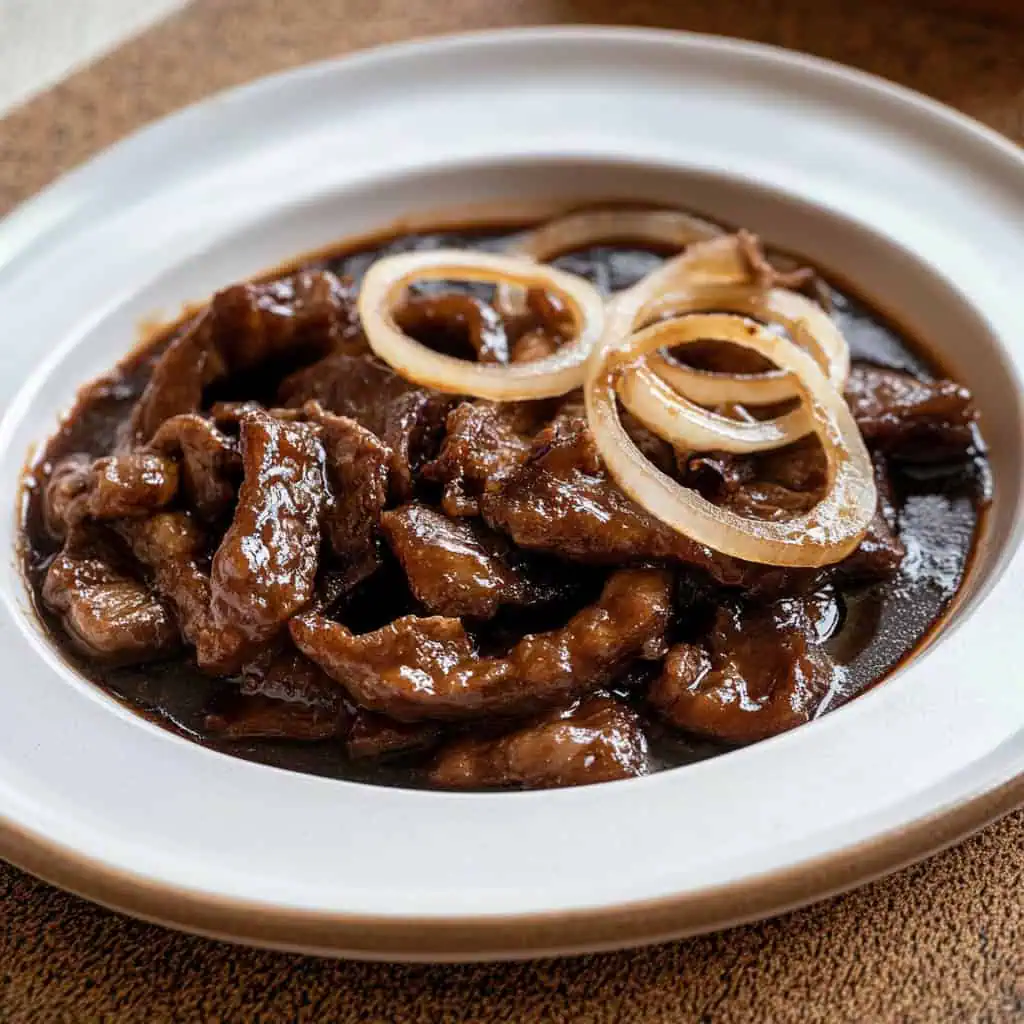
Why You'll Love This Recipe
- Perfect balance of savory and tangy flavors (malinamnam at maasim)
- Tender, juicy beef slices that melt in your mouth
- Rich sauce that's perfect with steamed rice
- Easy-to-follow instructions, even for beginners
- Ready in under 2 hours
- Made with simple, accessible ingredients
- Authentic Filipino taste that reminds you of home
Ingredients
This recipe uses traditional ingredients that create the perfect flavor balance. Thinly sliced beef sirloin absorbs the marinade beautifully while staying tender. Calamansi juice provides that signature Filipino tang that brightens the dish, while soy sauce delivers rich umami depth.
Garlic and black pepper add aromatic complexity, and the onions serve double duty – they flavor the sauce when cooked and provide fresh crunch when added as garnish. Together, these simple ingredients create the distinctive sweet-sour-savory profile that makes Bistek Tagalog a beloved Filipino classic.
The additional water helps create just enough sauce to spoon over your rice, ensuring not a drop of flavor goes to waste.
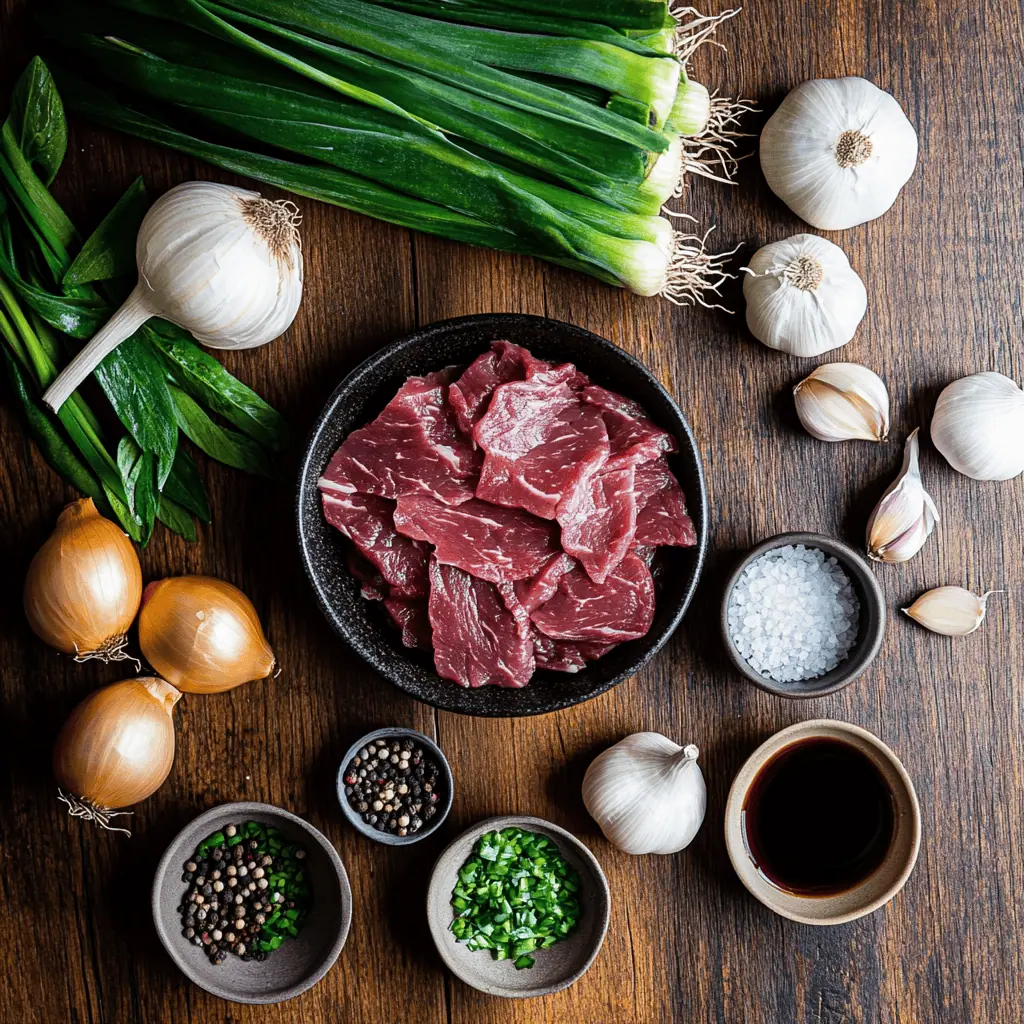
For the Marinade:
- 2 pounds beef sirloin or top round, thinly sliced
- ¼ cup calamansi juice or lemon juice
- ¼ cup soy sauce
- 1 large onion, thinly sliced
- 1 whole head garlic, minced
- ¼ teaspoon black pepper
For Cooking:
- 3 tablespoons canola or vegetable oil
- 1 cup water
- Salt to taste
- 1 large onion, sliced into rings for garnish
Equipment
- Large mixing bowl - For marinating the beef thoroughly and ensuring even flavor distribution
- Sharp knife - Essential for thinly slicing beef and cutting uniform onion rings
- Heavy-bottom skillet or pan (12-inch) - Provides even heat distribution for perfect browning and braising
- Tongs - Helps safely turn and handle the meat during cooking
- Measuring cups and spoons - Ensures accurate ingredient proportions
- Cutting board - Provides a stable, clean surface for preparing ingredients
- Garlic press (optional) - Makes mincing garlic faster and more efficient

How To Make
- In a large mixing bowl, combine 2 pounds of thinly sliced beef sirloin, ¼ cup calamansi juice, ¼ cup soy sauce, 1 sliced large onion, 1 head of minced garlic, and ¼ teaspoon black pepper. Gently massage the marinade into the meat for 2 minutes. Allow to marinate at room temperature for 30 minutes - do not exceed 1 hour to prevent the meat from becoming mushy.
- After marinating, separate the meat and vegetables from the marinade liquid, reserving the liquid for later use. Pat the meat dry with paper towels. Heat 3 tablespoons of cooking oil in a heavy-bottom skillet over high heat (350°F/175°C) until the oil begins to shimmer. Working in batches to avoid overcrowding, sear the beef for 3-5 minutes per side until well-browned. Remove the meat and set aside.
- Reduce heat to medium (325°F/163°C) and in the same pan, sauté the reserved onions and garlic until they become soft and translucent. Return the browned beef to the pan. Pour in the reserved marinade and 1 cup of water. Reduce heat to low (275°F/135°C), cover the pan, and let it simmer for 40-50 minutes until the meat is tender and the sauce has reduced.
- Season with salt to taste. Before serving, garnish with fresh onion rings. Serve hot with steaming white rice.

Tips from Lola's Kitchen
- Choose the right beef cut: Select beef with some marbling for better flavor and juiciness. The fat distributed throughout the meat will render during cooking, adding richness to both the meat and sauce.
- Proper slicing technique: Always slice meat against the grain for maximum tenderness. This cuts through the muscle fibers, making each bite easier to chew.
- Watch your marination time: Don't marinate longer than 1 hour as the acid in calamansi can break down the meat too much, resulting in mushy texture rather than tender.
- Use fresh ingredients: Fresh calamansi produces the authentic Filipino flavor profile. If unavailable, fresh lemon or lime juice works as a substitute.
- Temperature management: Let meat rest at room temperature for 15 minutes before cooking to ensure even cooking throughout.
- Save those flavorful juices: Collect any meat juices released during frying and add them back to the sauce for extra depth of flavor.
- Onion timing matters: Adding some onions at the beginning for flavor and fresh ones at the end gives you both caramelized sweetness and fresh crunch.
Substitutions
- Beef alternatives: Pork sirloin or chicken thighs can work well if beef isn't available. Adjust cooking time accordingly - pork needs about 30-40 minutes, chicken about 20-25 minutes.
- Citrus options: If calamansi isn't available, use a 2:1 ratio of lemon to lime juice for a close flavor match. Rice vinegar with a touch of sugar can also work in a pinch.
- Soy sauce substitutes: Liquid aminos or light soy sauce can replace regular soy sauce. For a lower-sodium version, use low-sodium soy sauce and adjust salt accordingly.
- Oil choices: Any neutral cooking oil works well. Avoid olive oil as its flavor can compete with the traditional taste profile.
- Onion varieties: White onions are traditional, but red onions or shallots can provide a slightly sweeter flavor profile that complements the dish nicely.
Troubleshooting
- Tough meat?
- Slice the beef thinner next time, ideally ⅛ to ¼ inch thick
- Ensure you're cooking at the right temperature - too high will tighten the proteins
- Try a more tender cut of beef like ribeye or sirloin
- Braise longer at a lower temperature to break down connective tissues
- Too salty?
- Add a splash of water or extra calamansi juice to dilute
- Reduce soy sauce in the marinade next time or use low-sodium soy sauce
- Balance with extra onions, which add sweetness to counter saltiness
- Serve with extra rice to balance the flavors
- Sauce too thin?
- Simmer uncovered for 5-10 additional minutes to reduce
- If needed, make a slurry with 1 teaspoon cornstarch and 2 tablespoons cold water, then stir into the sauce
- Not tangy enough?
- Add a splash of fresh calamansi juice at the end of cooking
- Keep some calamansi halves on the side for diners to squeeze as desired
Storage & Reheating
- Refrigeration: Store in an airtight container for up to 3 days. The flavors actually develop and improve overnight!
- Freezing: Bistek Tagalog freezes well for up to 2 months in freezer-safe containers. Thaw overnight in the refrigerator before reheating.
- Stovetop reheating: The best method is to reheat in a pan over medium-low heat (275°F/135°C) with a splash of water to revive the sauce. Cover and heat until the meat is warmed through, about 5-7 minutes.
- Microwave reheating: Heat for 2-3 minutes on medium power, stirring halfway through. Cover with a microwave-safe lid or damp paper towel to prevent splattering and help retain moisture.
- Serving after storage: Consider adding fresh onion rings when serving leftover bistek to bring back that crisp element that makes the dish special.

FAQ
Can I use other cuts of beef?
Yes, ribeye or tenderloin work exceptionally well but are more expensive. Chuck or flank steak can be used for a more economical option, but they require longer cooking time to become tender.
Why is my sauce too watery?
The most common reason is not letting it simmer long enough. Simmer uncovered for 5-10 additional minutes to reduce. Also, make sure you're patting the beef dry before searing to reduce excess moisture.
Can I make this ahead for a party?
Absolutely! Bistek Tagalog actually tastes even better the next day as the flavors meld together. Make it a day ahead, refrigerate, and reheat gently before serving.
How thin should I slice the beef?
Aim for ⅛ to ¼ inch thickness. Too thin and it will overcook quickly; too thick and it won't absorb the marinade properly or become tender in the cooking time.
Can I add vegetables to make it a complete meal?
Definitely! Bell peppers, carrots, or mushrooms make excellent additions. Add firmer vegetables when you return the beef to the pan, and more delicate ones in the last 10 minutes of cooking.
Is this dish gluten-free?
Not traditionally, due to the soy sauce. However, you can easily make it gluten-free by substituting tamari or certified gluten-free soy sauce.
What's the best rice to serve with Bistek Tagalog?
Medium or long-grain white rice is traditional. Jasmine rice works particularly well with its subtle aroma complementing the savory-tangy profile of the dish.
Related
Looking for other recipes like this? Try these:
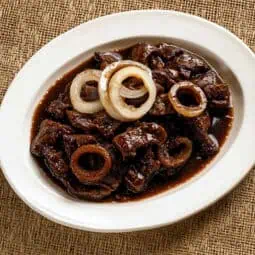
Bistek Tagalog (Filipino Beef Steak)
Equipment
- Large mixing bowl (for marinating) Panghaluan ng marinada
- Sharp knife (for slicing onions) Panghiwa
- Heavy-bottom skillet or pan (12-inch) Kawali
- Tongs (for turning meat) Sipit
- Measuring cups and spoons Panukat
- Cutting board Sangkalan
- Garlic press (optional) Pangpiga ng bawang
Ingredients
For the Marinade
- 2 pounds beef sirloin or top round thinly sliced - Karne ng baka
- ¼ cup calamansi juice or lemon juice - Katas ng calamansi
- ¼ cup soy sauce - Toyo
- 1 large onion thinly sliced - Sibuyas
- 1 whole head garlic minced - Bawang
- ¼ teaspoon black pepper - Paminta
For Cooking
- 3 tablespoons canola or vegetable oil - Mantika
- 1 cup water - Tubig
- Salt to taste - Asin
- 1 large onion sliced into rings for garnish - Sibuyas na pang-garnish
Instructions
- In a large mixing bowl, combine 2 pounds of thinly sliced beef sirloin, ¼ cup calamansi juice, ¼ cup soy sauce (toyo), 1 sliced large onion, 1 head of minced garlic (bawang), and ¼ teaspoon black pepper (paminta). Gently massage the marinade into the meat for 2 minutes. Allow to marinate at room temperature for 30 minutes - do not exceed 1 hour to prevent the meat from becoming mushy (hindi dapat lumampas ng 1 oras).
- After marinating, separate the meat and vegetables from the marinade liquid, reserving the liquid for later use. Pat the meat dry with paper towels. Heat 3 tablespoons of cooking oil (mantika) in a heavy-bottom skillet over high heat (350°F/175°C) until the oil begins to shimmer. Working in batches to avoid overcrowding, sear the beef for 3-5 minutes per side until well-browned. Remove the meat and set aside.
- Reduce heat to medium (325°F/163°C) and in the same pan, sauté the reserved onions and garlic until they become soft and translucent. Return the browned beef to the pan. Pour in the reserved marinade and 1 cup of water (tubig). Reduce heat to low (275°F/135°C), cover the pan, and let it simmer for 40-50 minutes until the meat is tender and the sauce has reduced.
- Season with salt (asin) to taste. Before serving, garnish with fresh onion rings (sibuyas na pang-garnish). Serve hot with steaming white rice (kanin).
Tips from Lola's Kitchen
- Choose beef with some marbling for better flavor
- Slice meat against the grain for tenderness
- Don't marinate longer than 1 hour to prevent mushy meat
- Use fresh calamansi if available for authentic flavor
- Let meat rest at room temperature before cooking
- Save meat juices during frying to add back to sauce
Nutrition
The Story Behind Bistek Tagalog (Filipino Beef Steak)
The beloved Bistek Tagalog tells a fascinating story of Filipino culinary adaptation, tracing its roots to the Spanish colonial era's "bistec encebollado" (beefsteak with onions). During the 333 years of Spanish rule in the Philippines, locals ingeniously transformed this European dish by incorporating native ingredients like calamansi and our beloved toyo, creating something uniquely Filipino.
While the Spanish version relied heavily on olive oil and vinegar, Filipino cooks made the dish their own by introducing calamansi's distinct citrus notes and dark soy sauce's umami depth. This adaptation wasn't just about taste - it reflected the resourcefulness of Filipino home cooks who masterfully balanced expensive beef with affordable local ingredients, making it accessible to more Filipino families.
The "Tagalog" in its name points to its popularity in the Luzon regions, particularly in Manila and surrounding provinces, where it became a staple of family celebrations and everyday meals alike. The dish perfectly exemplifies the Filipino talent for "Filipinizing" foreign dishes, similar to how we transformed Chinese pancit or Spanish adobo into distinctly Filipino favorites.
Today, Bistek Tagalog stands as a testament to Filipino culinary innovation, appearing on both humble family dinner tables and upscale Filipino restaurant menus worldwide. Modern versions might feature premium beef cuts or extra flourishes, but the soul of the dish remains unchanged - it's still that perfect marriage of beef, calamansi, toyo, and onions that generations of Filipinos have come to love.
What makes this dish particularly special is how it embodies the Filipino value of "resourcefulness meets flavor." Each family has their own special twist - some add bell peppers, others swear by specific soy sauce brands, and many have secret marination times passed down through generations. Yet somehow, every version manages to taste like home, making Bistek Tagalog not just a dish, but a cherished part of Filipino culinary heritage.







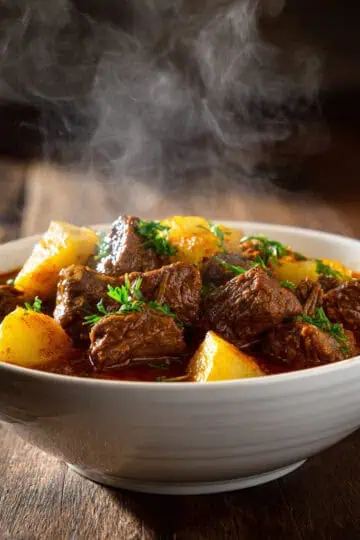
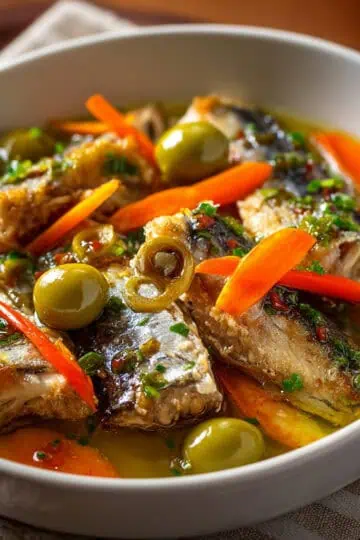

Comments
No Comments